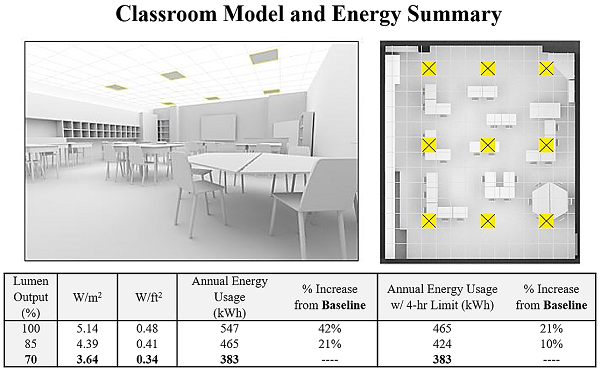Energy impact of human health and wellness lighting recommendations for office and classroom applications

Authors: Sarah Safranek, Jessica M. Collier, Andrea Wilkerson and Robert G. Davis
Pacific Northwest National Laboratory
Study finds that systems are being specified with "significant increases in indoor light levels"
Circadian lighting is a pressing topic of discussion in the lighting community. The definition of circadian lighting varies, but it generally refers to lighting that accounts for emerging science related to the role light plays in fundamental human physiological processes. While the melatonin response to light at night is well documented, what this means for sleep, mood, and overall wellness is undetermined. The science of how light affects specific circadian processes and the importance of light relative to other factors like diet, genetics, and activity levels is still in very early stages.
Many questions remain regarding how lighting systems and building design should adapt to incorporate the latest research. In the meantime, several design guidelines have been published to date by the International Well Building Institute, Underwriters Laboratories, and the California High-Performance Schools program. A Pacific Northwest National Laboratory (PNNL) study, funded by the U.S. Department of Energy and published in the journal Energy & Buildings, evaluated the potential energy impacts of circadian lighting design recommendations detailed in WELL v2 Q2 2019, UL Design Guideline 24480, and Collaborative for High Performance Schools Core Criteria 3.0. The study found significant increases in indoor light levels and corresponding lighting energy use resulting from meeting current circadian lighting design recommendations.
An open office and a classroom were modeled, with the luminaire lumen output, spectral power distribution, surface reflectance distribution, and desk orientation varying between the simulations in order to explore the magnitude of the different parameters. The authors found that meeting current Illuminating Engineering Society (IES) illuminance recommendations did not satisfy existing equivalent melanopic lux and circadian stimulus values for any of the office and classroom circadian lighting recommendations. In some cases, meeting the circadian metric recommendations required an average illuminance that was more than double the IES recommendations, which may negatively affect lighting quality and increase energy use.

Perspective (left) and floorplan (right) images of the classroom model used to model illuminance and equivalent melanopic lux. An energy summary for the classroom simulations is included in the table, with the 70% lumen output condition representing the baseline scenario.
Using results from the two models and 45 unique simulation conditions, the study estimates that lighting energy use may increase by 10% to 100% because of the higher luminaire light levels used to meet the circadian lighting design recommendations listed in current building standards.
Further research may show more-efficient ways to meet design recommendations through varied light distribution or optimized spectral characteristics, as well as advanced control systems. Until circadian lighting design metrics and effective delivery of light stimulus are better understood in realistic settings with recognizable health and well-being benefits, the tradeoffs between design recommendations and energy efficiency goals cannot be fully expressed.
View the full report »
Don’t miss the next big lighting story…Click here to subscribe to the inside.lighting InfoLetter |




